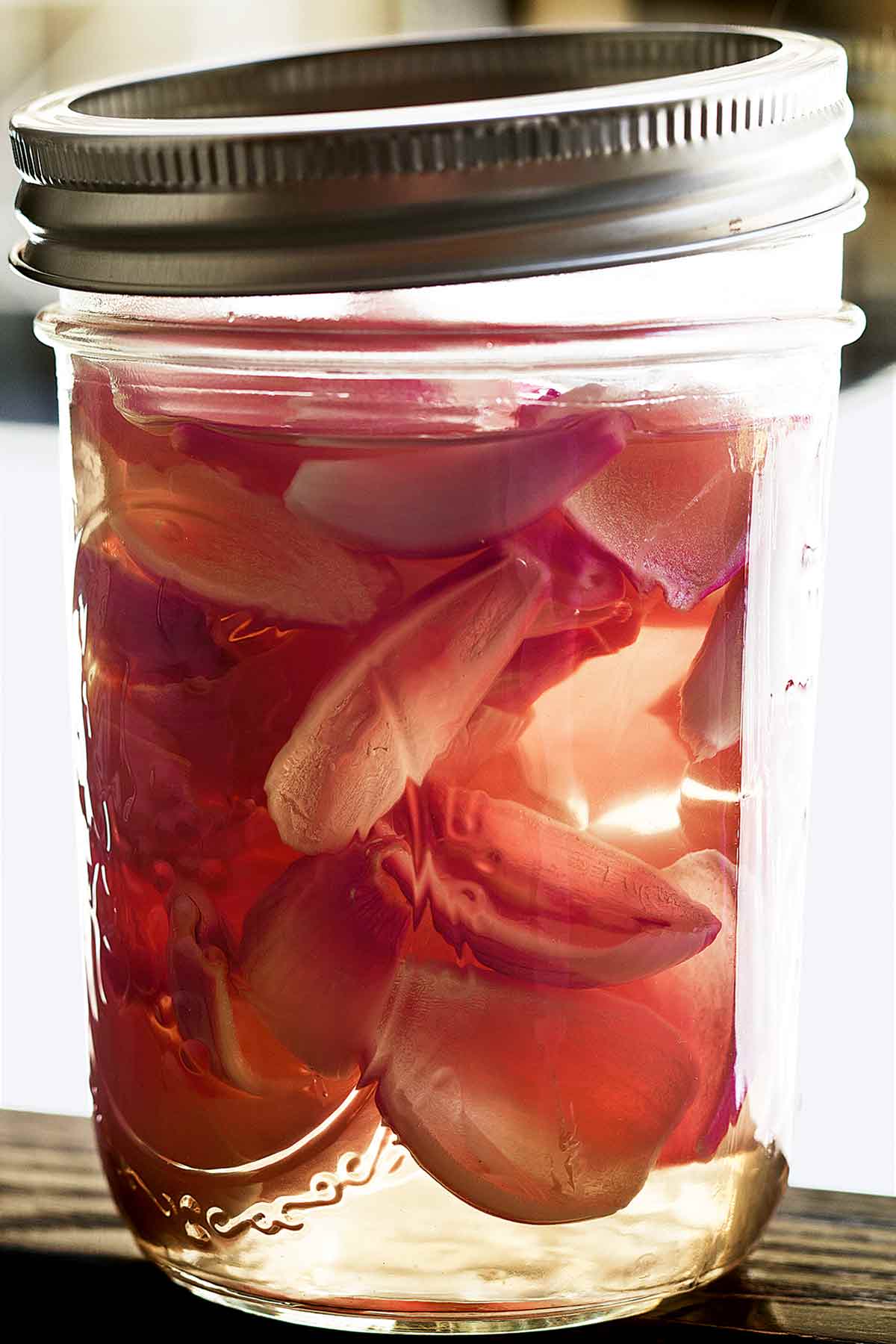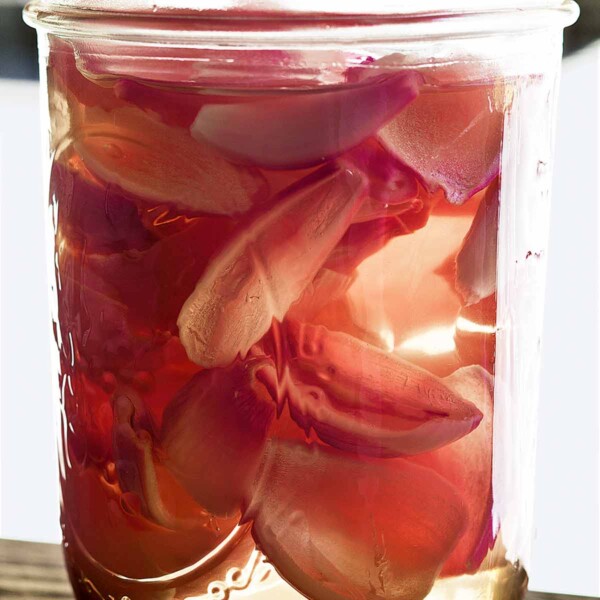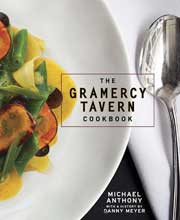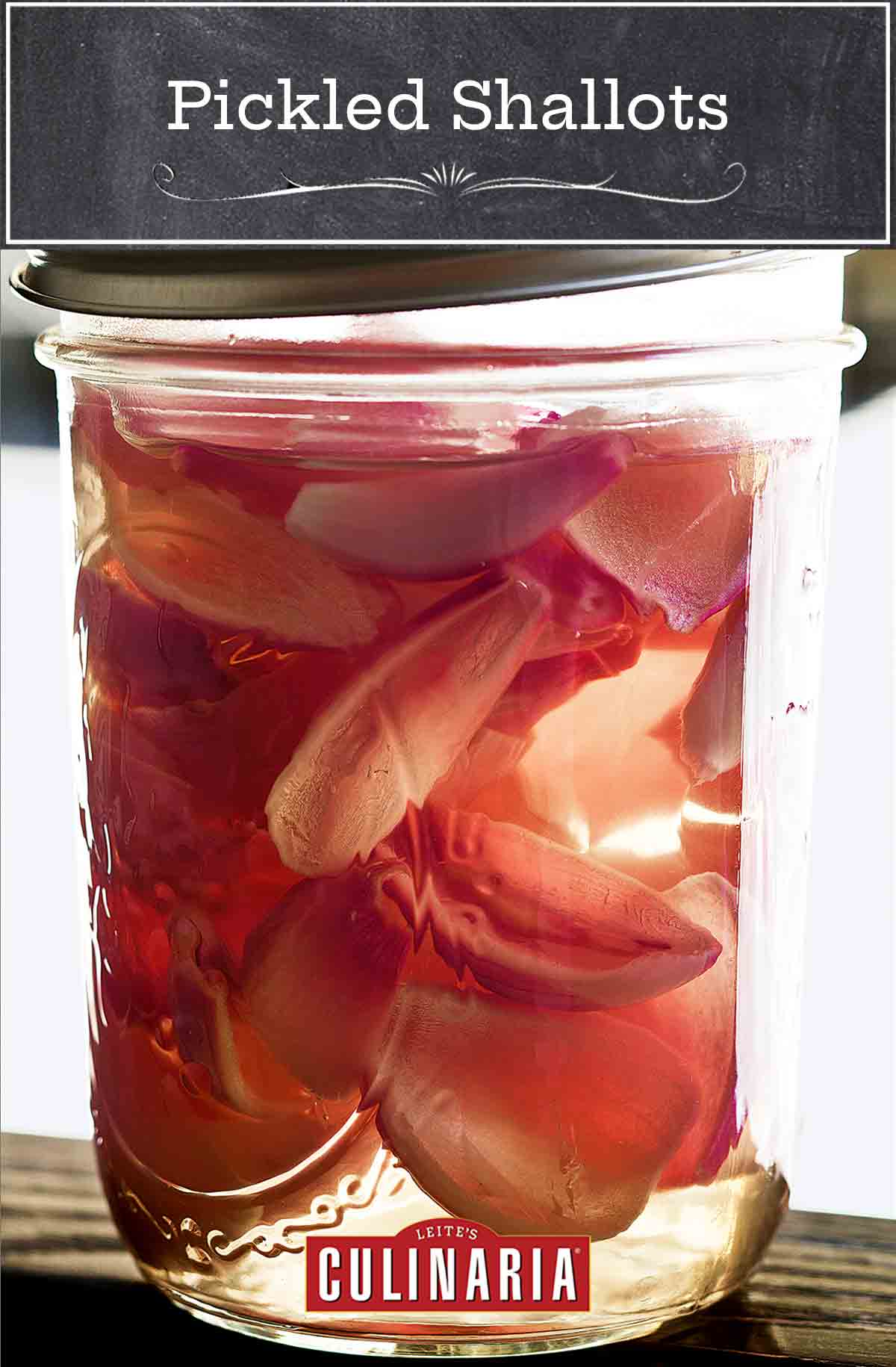
These pickled shallots are pretty instant in terms of gratification, seeing as they take just 6 hours of pickling time in your fridge, as opposed to several weeks on your pantry shelf, and your reward is unexpected bursts of acidity in all the right places—cheese plates, salads, tacos, sandwiches, burgers, omelets (we could go on but we’d much rather you let us know in a comment below how you fancy these pink lovelies).–Michael Anthony

Pickled Shallots
Ingredients
- 5 shallots
- 3/4 cup unseasoned rice vinegar*
- 1/4 cup cold water
- 1/4 cup granulated sugar
- 1 tablespoon kosher salt
Instructions
- Halve each shallot lengthwise and pull apart the layers to form petals. You should have about 2 cups. Place the shallots in a medium bowl.
- In a small saucepan, combine the vinegar, water, sugar, and salt. Bring to a boil over high heat, stirring until the sugar and salt are dissolved. Pour the pickling liquid over the shallots and cover them with a plate to keep them submerged. [Editor’s Note: The shallots may not be completely submerged, but that’s okay.] Let cool to room temperature.
- Cover the bowl (as well as the plate) with plastic wrap and refrigerate for at least 6 hours, or overnight. Transfer the pickles and liquid to a container, cover, and refrigerate for up to several weeks.
Notes
*Can I substitute white vinegar for rice wine vinegar in my pickled shallots?
In this recipe, Michael Anthony uses unseasoned rice wine vinegar because of the complexity it brings to the pickled shallots. With only 5 ingredients, rice wine vinegar bumps up the flavor of the shallots—which can be somewhat subtle. Distilled white vinegar is the go-to for pickling and can be used, but in this instance, you’ll find that your shallots will lose a lot of the nuances brought out by a more delicate-tasting vinegar.
Nutrition
Nutrition information is automatically calculated, so should only be used as an approximation.
Recipe Testers’ Reviews
I made this pickled shallots recipe a week ago and am already dangerously close to finishing them off. These are as easy and delicious as can be with 10 minutes of actual work involved. The use of unseasoned Japanese rice vinegar is key here. It has a smoothness and lack of acidic bite that brings out the flavor of the shallots perfectly, making for a sweet and subtle pickle that can be tossed into any dish.
Vinegar lovers will enjoy this quick pickled shallots recipe, which turns the shallots a lovely pink after preserving. They provided a tangy counterpoint to harissa-spiced turkey burgers and should be a great accompaniment to any kind of pulled pork sandwich or barbecue beef sandwich. The pickles are pretty heavy on the vinegar flavor, though, so people who aren’t vinegar fans will want to keep that in mind and maybe adjust the ratios in the recipe.












This is a great recipe! Its so nice to have a recipe for something pickled that only takes six hours from start to ready-to-eat. Is there any benefit to letting it pickle longer? Will the flavor be better? I know sometimes people let pickles and other vegetables pickle for up to a few days or even longer. Thanks for the response, and thank you for the great recipe!
You’re so very welcome, Billy! If you let the pickles go a touch longer they may take on a slightly more pickled flavor and may soften a little more. Can’t wait to hear what you think!
I improvised some months back and put chopped up shallots in a jar and covered with plain white vinegar. I used part of them in a salad that afternoon and finished the rest off within the week. The vinegar tamed that rough raw taste of the shallot and added tang. when I finished the shallots I made salad dressing with the vinegar. I know this isn’t proper way to pickle, but it was quick and easy and added a flavor punch to savory dishes. Shallots in any way shape or form are wonderful!
Ann, if it works, and you like, who am I to judge?! Go for it.
I know ramps are fairly common in the Eastern States but does anyone know if we are luck enough to have them growing in Washington State? When I mow in early spring i sometimes get a wonderful mild onion smell coming from something looking like a chive and wonder if that could be our ramp.
Carol Ann, let’s see if any of our readers can help. I think that scent your smelling is wild chives. Ramps have a much wider, flatter leaf than chives.
Thank you David. You’re right!
My pleasure, Carol Ann.
if your cutting the stuff that comes up all over my garden here in NJ in the spring, I’m pretty sure they are wild chives. Leaves are thin, hollow, tall – they look like store bought chives and taste stronger and tougher. Ramps have a broader, softer rather shorter leaf.
Hope this helps.